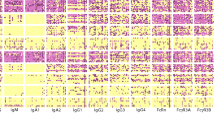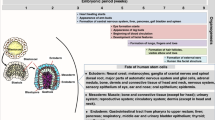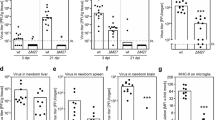Abstract
Neonates face a high risk of infection because of the immaturity of their immune systems. Although the transplacental transfer of maternal antibodies to the fetus may convey improved postnatal immunity, this transfer occurs late in gestation and may fail to prevent in utero infection. Both fetal immunization and in utero exposure to antigen can result in a state of immunologic tolerance in the neonate. Tolerance induction of fetal and premature infant lymphocytes has become a paradigm for neonatal responsiveness1,2. However, fetal IgM responses have been demonstrated to maternal immunization with tetanus toxoid and to congenital infections such as rubella, toxoplasma, cytomegalovirus and human immunodeficiency virus3,4,5,6. Moreover, 1-week-old infants can respond to standard pediatric vaccination, and neonates immunized with polysaccharide antigens do not develop immunologic tolerance7. Here, direct immunization of the baboon fetus with recombinant hepatitis B surface antigen produced a specific fetal IgG antibody response. No specific maternal antibody response was detected, eliminating the possibility of vertical antibody transmission to the fetus. Some infants also responded to later vaccinations with hepatitis B surface antigen, indicating that no immunological tolerance was induced by prior fetal immunization. These results characterize the ability of the fetal immune system to respond to in utero vaccination. We demonstrate that active fetal immunization can serve as a safe and efficient vaccination strategy for the fetus and neonate.
This is a preview of subscription content, access via your institution
Access options
Subscribe to this journal
Receive 12 print issues and online access
$209.00 per year
only $17.42 per issue
Buy this article
- Purchase on Springer Link
- Instant access to full article PDF
Prices may be subject to local taxes which are calculated during checkout

Similar content being viewed by others
References
Bona, C. & Bot, A. Neonatal immuno-responsiveness. Immunologist 5, 5–9 ( 1997).
Owen, R.D. Erythrocyte antigens and tolerance phenomena. Proc. R. Soc. Lond. Bull. 146, 8–18 ( 1957).
Gill, T.J. et al. Transplacental immunization of the human fetus to tetanus by immunization of the mother. J. Clin. Invest 72, 987–996 (1983).
Enders, G. Serologic test combinations for safe detection of rubella infections. Rev. Infect. Dis. 7, S113–S122 (1985).
Naot, Y., Desmonts, G. & Remington, J.S. IgM enzyme-linked immunosorbent assay test for the diagnosis of congenital Toxoplasma infection. J. Pediatr. 98, 32–36 (1981).
Griffiths, P.D., Stagno, S. & Pass, R.F. Congenital cytomegalovirus infection: diagnostic and prognostic significance of the detection of specific immunoglobulin M antibodies in cord serum. Pediatrics 69, 544– 549 (1982).
Howard, J. G. & Hall, C. Lack of neonatal susceptibility to induction of tolerance by polysaccharide antigens. Eur. J. Immunol. 6, 486–492 ( 1976).
Del Portillo, H.A., Schmidt, G.W. & Damian, R.T. Immunochemical analysis of baboon (Papio cynocephalus ) IgG subclasses. Vet. Immunol. Immunopathol. 16, 201–214 (1987).
Attanasio, R., Allan, J.S., Anderson, S.A., Chanh, T.C. & Kennedy, R.C. Anti-idiotypic antibody response to monoclonal anti-CD4 preparations in nonhuman primate species. J. Immunol. 146, 507–514 (1991).
Kennedy, R.C., Shearer, M.H., Hildebrand, W.H. & Simmonds, R.S. The use of nonhuman primates in immunological based investigators. Immunologist 5, 150–155 (1997).
Shearer, M.H. et al. Serologic crossreactions among primate immunoglobulins. Dev. Comp. Immunol. 6, 547–557 (1995).
Shearer, M.H. et al. The baboon as a nonhuman primate model for assessing the effects of maternal immunization with Haemophilus influenzae type b polysaccharide vaccines. Infect. Immunol. 65, 3267– 3270 (1997).
Kennedy, R.C. & Dreesman, G.R. Common idiotypic determinant associated with human antibodies to hepatitis B surface antigen. J. Immunol. 130, 385–389 (1983).
Acknowledgements
Acknowledgments This work was supported by a grant from the Oklahoma Center For The Advancement of Science And Technology and grants T32 A1-07634 and P40 RR-12317 from the National Institutes of Health.
Author information
Authors and Affiliations
Corresponding author
Rights and permissions
About this article
Cite this article
Watts, A., Stanley, J., Shearer, M. et al. Fetal immunization of baboons induces a fetal-specific antibody response . Nat Med 5, 427–430 (1999). https://doi.org/10.1038/7426
Received:
Accepted:
Issue Date:
DOI: https://doi.org/10.1038/7426
This article is cited by
-
Age-associated mRNA expression changes in bovine endometrial cells in vitro
Reproductive Biology and Endocrinology (2017)
-
Role of the ER stress in prostaglandin E2/E-prostanoid 2 receptor involved TGF-β1-induced mice mesangial cell injury
Molecular and Cellular Biochemistry (2016)
-
Berberine regulates the expression of E-prostanoid receptors in diabetic rats with nephropathy
Molecular Biology Reports (2014)
-
Hematopoietic-Prostaglandin D2 synthase through PGD2 production is involved in the adult ovarian physiology
Journal of Ovarian Research (2011)
-
Arachidonic Acid Induces Production of 17,20β‐Dihydroxy‐4‐pregnen‐3‐one (DHP) via a Putative PGE2 Receptor in Fish Follicles from the Eurasian Perch
Lipids (2011)



